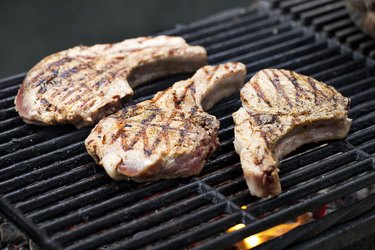
Beyond beef coming from cows and pork from pigs, the meats have other important differences. Color, processing, preparation and taste differ. Understanding the subtle differences between the meats will help you choose the best product, method of preparation and accompaniments to your main course.
Color
Video of the Day
Though the National Pork Board's slogan might say otherwise, pork is not classified as white meat. Because the pig's livestock status and the amount of oxygenated protein in the meat, pork is considered red meat by U.S. Department of Agriculture. The color of cooked pork, especially cuts like loins and chops, cause confusion because the meat becomes a light brown or off-white once it is cooked. On the other hand, beef is clearly a red meat. Raw beef's bright red color turns a lovely, dark brown once fully cooked, leaving no doubt it is red meat.
Video of the Day
Processing
After slaughter, beef is aged to increase the tenderness and flavor of the meat. This process can last several and should only take place in commercial facilities. Pork is not aged, though some cuts are salted, cured or smoked to make bacon and ham. Both meats must be inspected by the USDA, but beef has far more rigorous grading process to indicate the quality of the meat. Prime, Choice and Select grades of beef are available in most grocery stores. Only pork graded "acceptable" is sold in grocery stores.
Preparation
Both pork and beef can be prepared using the same methods, including grilling, braising, roasting and broiling. The USDA recommends cooking beef and pork until it reaches 145 degrees Fahrenheit, though ground pork and beef should reach 160 F. As you may have noticed at restaurants, you have the option to choose how you want your beef done -- ranging from rare to well-done -- while pork can be served medium-rare to well-done.
Taste
Because of the variety of cuts available for both pork and beef, it is hard to pinpoint one general flavor and texture for the meats. Bacon has a vastly different flavor from pork loin, just as ground beef tastes different than steak. In general, pork has a lighter, milder flavor than beef. Sweet, tart ingredients, like apple or cherry, and flavors like garlic and sage, complement the flavor of the pork and are commonly paired with the meat. Beef's intense, hearty flavor stands up well to pungent flavors. Marinades and sauces made with red wine, soy sauce, garlic or onion complement the flavor of the beef, though the meat is versatile and can be paired with many ingredients.
Texture
The cut of the beef or pork makes a big difference to the fat content of the meat. Lean cuts, like beef tenderloin and pork loin, can easily dry out while cooking. Basting the meat -- or using cooking methods like braising -- will ensure that lean cuts remain moist and flavorful. Understand your chosen cut of meat before you choose how to cook it, so you can adjust your cooking methods to make the most of your meat.
- U.S. Department of Agriculture Food Safety and Inspection Service: Fresh Pork from Farm to Table
- Minnesota Extension Service: Aging Beef
- U.S. Department of Agriculture Food Safety and Inspection Service: Beef from Farm to Table
- U.S. Department of Agriculture Food Safety and Inspection Service: Is It Done Yet?
- Exploratorium: What Gives Meat Its Flavor?
- Meals For You: A Guide to Meat Cuts: Pork
- Beef: It's What's for Dinner: Interactive Butcher Counter